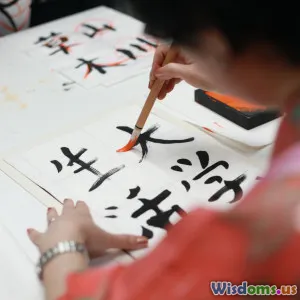
One Month Challenge I Tried to Learn Japanese in 30 Days
8 min read I took on a 30-day Japanese learning challenge with immersive strategies and share my surprising progress and tips. (0 Reviews)
One Month Challenge: I Tried to Learn Japanese in 30 Days
Learning a new language is a daunting but rewarding endeavor for many. Faced with the allure of anime, manga, and Japan's rich culture, I set myself an audacious goal: to learn Japanese in just 30 days. Could it be done? What strategies work best for a rapid start? What pitfalls might learners encounter? This article chronicles my experience, insights gleaned, and practical advice for anyone inspired to undertake a similar challenge.
Why Learn Japanese in 30 Days?
Choosing to learn Japanese in a month may seem overly ambitious — and it is! However, the reasoning went beyond mere curiosity. I wanted to:
- Test the limits of language acquisition speed with a time-bound challenge.
- Gain foundational conversational skills to enhance travel or communication in Tokyo or other parts of Japan.
- Explore effective learning techniques to maximize retention and engagement.
Japanese is often cited as a Category IV language (per the U.S. Foreign Service Institute), indicating high difficulty for English speakers due to its different grammar, writing system, and vocabulary. This challenge aimed to establish whether substantial progress was achievable within a compressed timeframe.
The Approach: Laying the Groundwork
I divided the challenge into essential components: vocabulary, grammar, listening, speaking, reading, and writing. However, knowing 30 days is limited, my focus was on realistic proficiency targets — specifically basic conversational fluency and reading some Hiragana and Katakana.
Choosing Resources
- Textbooks: I used 'Genki I', a standard beginner Japanese book.
- Apps: Duolingo and Anki (for spaced repetition flashcards).
- Listening: JapanesePod101 for daily audio lessons.
- Writing Practice: Using worksheets to trace and memorize Kana characters.
Daily Commitment
I carved out 2-3 hours daily for focused Japanese study, split between morning vocabulary with flashcards, afternoon grammar and writing practice, and evening listening and speaking drills.
Week 1: Laying the Foundation
Motivation and Focus
Initially, enthusiasm propelled me. Learning Kana (both Hiragana and Katakana) was my first goal and key to unlocking Japanese written language. By day 5, I could recognize over 80% of Kana characters, slightly backwards reading but encouraging.
Vocabulary Buoyancy
I focused on high-frequency words, enabling rudimentary expression: greetings, family terms, common verbs (eat, go, see), and numbers.
Challenges
- Grammar concepts such as particles "wa", "ga" presented steep learning curves.
- Pronunciation nuances required multiple repetitions; for example, differentiating between "r" and "l" sounds.
Highlights
Being able to introduce myself politely in Japanese was a powerful morale boost, helping me sense real progress early on.
Week 2: Building Confidence and Complexity
Having mastered Kana, I began deeper grammar lessons and introduced Kanji—the logographic characters—gradually.
Breaking Down Grammar
Understanding sentence structure (Subject-Object-Verb) contrasted with English SVO order and required mental re-mapping. I learned simple verb conjugations, such as dictionary forms and polite forms.
Listening Practice
Daily exposure to native podcasts honed my ear to common phrases. Even without full comprehension, rhythm and intonation became clearer.
Speaking and Writing
Shadowing audio to mimic sentence intonation improved speech patterns. Writing simple sentences in Kana and experimenting with basic Kanji created a sense of accomplishment.
Insight
Realistically, fluency was out of reach; progress felt fragmented but motivating. I also realized the importance of consistency over intensity.
Week 3: Facing Plateaus and Boosting Interaction
Overcoming Frustration
Midway, I hit a plateau. Retention of vocabulary faltered, and grammar intricacies loomed larger. I rearranged study habits to include more frequent review sessions via spaced repetition, enhancing memory.
Language Exchange
I connected with Japanese speakers via language exchange apps (HelloTalk, Tandem). Simple chats about hobbies and daily life exposed me to colloquial usage and boosted confidence.
Cultural Immersion
Watching Japanese shows with subtitles allowed immersion. Some shows like "Shirokuma Cafe" provided approachable dialogue structures.
Week 4: Synthesis and Reflection
Milestone Achievements
By day 30, I could:
- Understand and participate in simple conversations about myself and interests.
- Read and write Hiragana and Katakana comfortably.
- Recognize about 50 basic Kanji used in everyday contexts.
Objective Self-Evaluation
While far from fluency, the foundation was solid enough to motivate continued learning. Practical speaking ability had increased with conversational exchanges.
Lessons Learned
- Daily immersion with native input is invaluable.
- Consistent review ensures vocabulary sticks.
- Language is not merely grammar and vocabulary, but cultural context enhances learning.
Conclusion: Is Learning Japanese in 30 Days Possible?
If the definition of "learning" is mastering conversational fluency or full literacy, 30 days is insufficient. However, this challenge proved it's possible to lay crucial groundwork toward practical comprehension and communication, especially when
dedicated strategies are employed.
Language acquisition requires patience and sustained effort. For those inspired by this challenge, remember:
- Set achievable short-term goals.
- Utilize diverse resources and active engagement.
- Practice speaking early to build confidence.
Ultimately, Japanese isn’t a language mastered overnight—it's a journey. Committing one month of intensive study jump-started mine, sparking motivation that will last much longer than the challenge.
Recommended Next Steps
For those embarking on your own language challenge:
- Use apps with spaced repetition systems.
- Engage in language exchange communities.
- Immerse yourself in media—anime, music, dramas.
- Keep a daily language journal to track progress and thoughts.
If you're eager to learn Japanese, start today. Thirty days can change how you see a language—and the world.
“Vision without action is a daydream. Action without vision is a nightmare.” – Japanese proverb
Rate the Post
User Reviews
Popular Posts





















